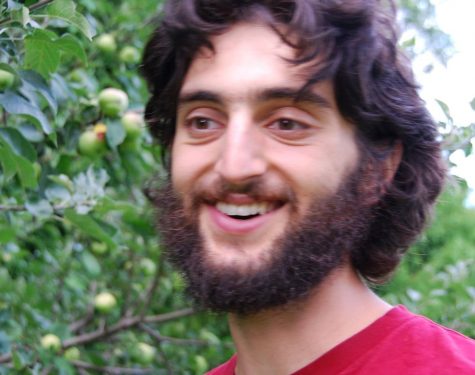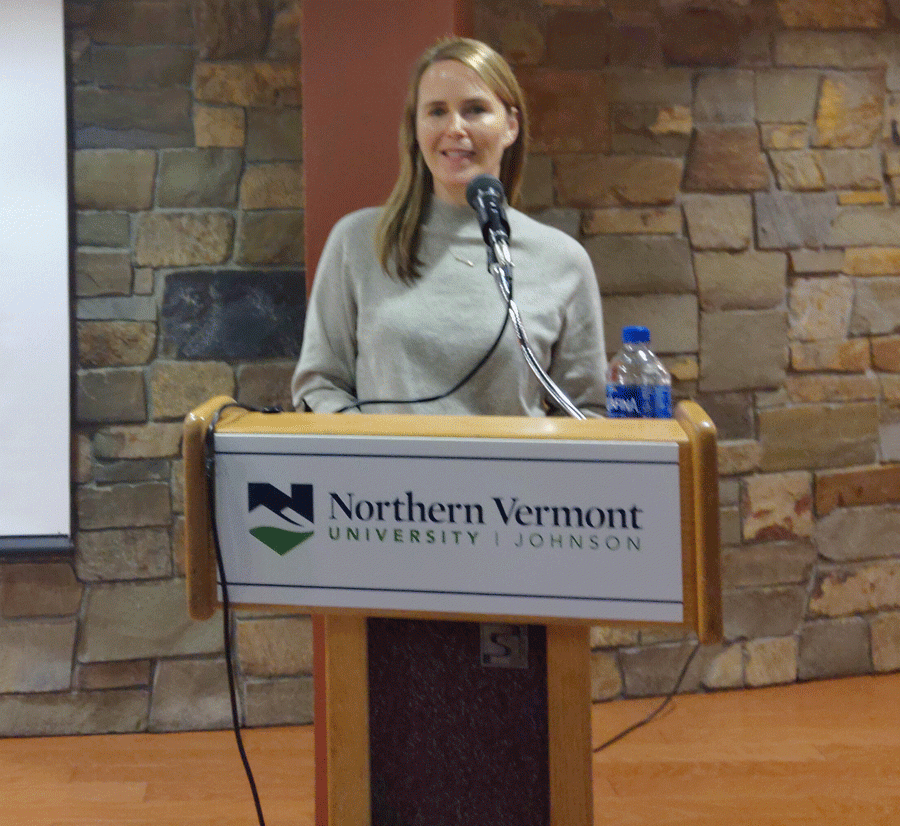O’Neill urges harm reduction in treatment of opioid addiction
Opioid use disorder is a disease, not a personal failing, said Kate O’Neill, and the stigma attached to it makes it harder to get treatment.
“We saw again and again peoples’ faces change when they learned that [my sister] had opioid use disorder. Everyone from social workers to the cardiologist in the hospital where she died,” said O’Neill.
O’Neill gave a talk at Stearn’s Performance space about the systemic failures in treating opioid use disorder, informed by her experiences watching her sister struggle with the disease. After her sister’s death from endocarditis, a complication of injection related infection, O’Neill wrote an obituary. The obituary delved into both her humanity and her struggles with opioid use disorder. The obituary went viral.
“I think that that obituary served as a form of connection,” said O’Neill. “It was this realization that we are not alone.”
After the obituary, she was hired by Seven Days to write a yearlong series of pieces on the opioid epidemic. Her pieces combine research, interviews, and her experience with her sister.
When Madelyn Linsenmeir, O’Neill’s sister, was 16, she got hooked on opiates after taking OxyContin at high school parties. “When Maddie started to get in some trouble… We thought based on our experiences that it was something that she would grow out. We had, but she didn’t.”
O’Neill says that the family couldn’t get Linsenmeir the most effective treatment. Because of the stigma and guilt around opioid use, they weren’t even told the most complete information around the disease.
“One of the things that I wish I had known was that on average, it takes a person with opioid use disorder eight years and four or five treatment attempts to achieve one year of remission,” said O’Neill.
“There seemed to be this expectation on the part of everyone, in the first rehab…to the last, that… she’s going to leave here and she’s going to be sober. And if she doesn’t, well, that’s a failure on our part.”
“If it’s going to take eight years to get one year of remission for opioid use disorder,” said O’Neill, “for a lot of that eight years people are going to be actively using drugs. So how do you keep people safe during that time?”
O’Neill presented research and anecdotes in support of harm reduction. Harm reduction “accepts that, for better or for worse, drug use is part of our world,” said O’Neill. “Given that it’s happening, how can we keep people safe?”
She pointed to medication assisted treatment. Medication assisted treatment means using methadone or buprenorphine while addicted. These drugs, while still addictive opioids, are far safer than the other options available to addicted people in search of a fix.
“Vermont has done a better job than any other state in the country of getting medication to people who are sick, and it’s still really, really hard to get,” said O’Neill. “If you live in a rural place and you don’t have a car and you really can’t get medication assisted treatment. There are a lot of doctors that don’t want to prescribe it.”
Harm reduction also includes syringe services programs, which provides sterile injecting equipment, HIV testing, and safe injection education. Supervised consumption sites, where there are medical professionals standing by while people consume opiates, are another practice of harm reduction.
O’Neill said that these programs are viewed by some, including many in the 12-step community, as encouraging opioid use. But she cited data from the Center for Disease Control and the American Medical Association that they actually reduce drug use, overdose deaths, and infections. “My sister… died of endocarditis, a disease that could well have been prevented if she had swabbed her skin with alcohol every time she injected, and used a sterile syringe.”
O’Neill also gave an economic argument for harm reduction, saying that each case of endocarditis costs the medical system 100-600 thousand dollars, far more than the cost of sterile syringes and alcohol swabs.
O’Neill suggested that everyone be equipped with Naloxone (better known as Narcan), a drug that reverses life-threatening effects of opioid overdoses. “I carry… two doses with me,” said O’Neill. “You all should be carrying it. You should ask university to do a training and hand it out to you. But if they don’t, you can go to pharmacy in Johnson and you can get this.”
In the audience were community members working on the issue locally. Dawn Tatro and her family are converting a church in Johnson into a community center with services for opioid addicts. They are also starting a coffee shop staffed by employees in recovery, in part to reduce community stigma around it.
Daniel Franklin, director of North Central Vermont Recovery Center, talked about his work as well. He said that a permanent syringe exchange is starting at 51 Brigham Street in Morrisville, in the office of a urologist who is also on the board of NCVRC. He urged everyone to reach out to him and NCVRC if they are struggling with addiction, or know someone who is.
A representative from Healthy Lamoille Valley was in attendance as well. Healthy Lamoille Valley is a community group trying to reduce substance use. They had cards available directing people to relevant resources.
O’Neill said that Safe Recovery in Burlington, Vt offers the most comprehensive and progressive services in the area for sufferers of opioid use disorder.
She said that in her interviews, “Everybody talks about it as a place where they go where they feel safe, where they feel not judged… and they feel cared for…. How they walk in the door and it’s the one place that they feel accepted. How fucking nuts is that, that you’re not feeling that in your doctor’s office, right? You’re not feeling that with your family.”
O’Neill’s articles can be found at https://www.sevendaysvt.com/author/kate-oneill
North Central Vermont Recovery Center in Morrisville can be contacted at 802-851-8120.
Safe Recovery in Burlington can be contacted at 802-488-6100.

Senior, Professional Studies
Grew up in East Montpelier, VT
Fall 2019 - Present
In my spare time that I pretend I still have, I play saxophone...



